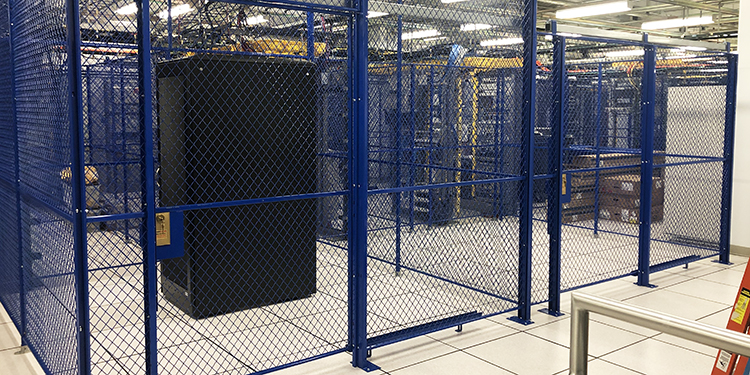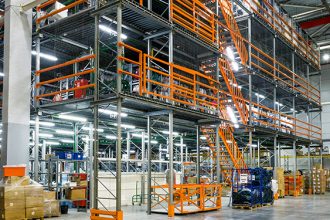Key Considerations When Designing And Specifying Data Center Caging

With the increasing push toward e-commerce and digital operations, organizations of all sizes — from small to large — are increasingly investing in computing power. That, in turn, has amplified the need for data centers. Used for remote storage, processing and distribution of large amounts of data, these centralized locations house a large collection of networked computer servers, as well as a variety of computing components such as switches, storage systems, servers, routers, and security devices. And, while electronic cybersecurity is a critical component of keeping these servers safe from attacks by those with malicious intent, so too are physical barriers such as data center caging.
Data center cages are modular structures composed of 2-inch posts upon which steel wire mesh panels are mounted. They include integrated swing or sliding doors that can be locked with a variety of security devices that enable varying degrees of access, depending on an individual’s preference. Additionally, because they are formed of steel wire mesh, the panels ensure maximum airflow throughout the space, which is critical to maintaining a temperature-controlled environment that prevents the equipment from overheating. Here are a few key questions to consider when undertaking a data center caging design project to ensure the right solution.
1. What type of data center is being equipped? There are four primary types of data centers whose servers require physical protection:
- Enterprise data centers, which are privately built, owned and operated facilities constructed solely for a single company’s use. Typically, these operations are used by large companies that specialize in processing massive amounts of data.
- Managed services data centers, which are similar to enterprise data centers, but are instead owned and operated by a third-party service provider. Smaller companies contract with these service providers to manage and maintain their servers and network, essentially leasing physical and digital equipment and space within the operation.
- Co-located data centers, which are third-party owned, dedicated spaces leased by smaller companies who provide their own servers and networking equipment, as well as their own staffers to maintain it. These are often found within metropolitan areas, serving office environments that may not have available space in-house for these technologies.
- Back-room data centers, which can be as small as a single server in the storage area of a small business.
The type of data center to be equipped with security cages impacts the size and layout of the structure. It can also influence the type or style of mesh panel selected based on factors specific to that company or operation.
2. What are the dimensions of the space to be guarded? In general, it is more affordable to create a layout that uses standard panel dimensions — many are offered in one-foot increments up to 10-feet wide and 5-feet high — rather than custom-constructed components. It’s a good idea to engage a wire partition manufacturer at the outset of the project for guidance and recommendations when determining how to design a layout.
3. How often might the cages need to be expanded? Operations that expect to make changes to their layout to accommodate equipment expansions, or those that house multiple tenants, should likewise use standard-sized panels. That enables greater system modularity for easy addition of more square footage, or to sub-divide an existing space. Additionally, unlike permanent walls, the panels can be easily disassembled and relocated without generating excess dirt and debris that could damage the servers or other technologies housed in the data center.
4. What degree of visibility into the cage is desired? The steel mesh used in data center cage sidewalls comes in a variety of opening shapes and dimensions. These range from a 2-inch x 2-inch square or a 1.5-inch diamond to much smaller, 0.5-inch mesh openings, as well as panels featuring a solid surface area with equally distanced perforations. The smaller the opening, the more difficult it is to pass an item through, such as a credit card, thumb drive or even a hand tool. Further, the smaller the openings and the larger the surface area around them, the more difficult it is to see into the cage — which may be preferable for highly sensitive applications. Alternately, mesh netting can be hung inside the cage to further obscure the view through panels with larger openings.
5. How wide are the access aisles between the cages? In data centers where floorspace is at a premium, access aisles between cages may be as narrow as 36 inches wide. With most standard swinging doors measuring 36 inches wide, a sliding door may be preferable to provide access without obstructing the aisle. Likewise, if the cage openings need to accommodate larger equipment, the sliding door can secure an opening beyond 48 inches wide while maintaining open aisles.
6. How sophisticated are the access security needs? Because they are mounted and operated differently, swinging doors offer a much broader selection of lock and handle options than sliding doors. The more complicated the locking mechanism required by the application, the more choices will be available for swinging doors.
7. Are there any areas that need to be blocked off separately from the servers? Particularly in large facilities, there may be multiple entry points that need to be secured or there may be equipment — such as generators or other systems — located within the same area as the servers that produce heat. Solid panels can be integrated to block off those areas while helping to preserve the controlled temperatures that the data center equipment requires.
Need more help specifying the optimal data center caging solution for your building? The wire partition members of the Protective Guarding Manufacturers Association (ProGMA) are available for guidance and recommendations.



